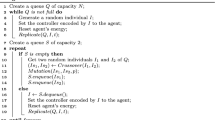Abstract
Embodied evolution (EE) is a methodology in evolutionary robotics in which, without simulations on a host computer, real robots evolve on the basis of their interactions with the actual environment. However, when adopting EE, we had to accept robot behavior with a low fitness, especially in the early generations. This article introduces pre-evaluation into the EE framework for a biped robot in order to restrain the behavior of a robot of which the fitness is estimated to be low, especially falling down onto the ground. We provide a comparative discussion on the conventional simulate-and-transfer method, the original EE method, and the proposed one in terms of calculation time, cost of fitness evaluation, and cost of simulation or modeling based on the evaluation experiments. We believe that the EE framework with pre-evaluation is applicable to a wide variety of optimization tasks in which the cost or the risk of fitness evaluation is not negligible.
Similar content being viewed by others
Explore related subjects
Discover the latest articles, news and stories from top researchers in related subjects.References
Nolfi S, Floreano D (2000) Evolutionary Robotics. MIT Press, Cambridge
Watson RA, Ficici SG, Pollack JB (2002) Embodied evolution: distributing an evolutionary algorithm in a population of robots. Robotics Auton Syst 39:1–18
Watson RA, Ficici SG, Pollack JB (1999) Embodied evolution: embodying an evolutionary algorithm in a population of robots. Proceedings of the 1999 Congress on Evolutionary Computation, pp 335–342
Usui Y, Arita T (2003) Situated and embodied evolution in collective evolutionary robotics, Proceedings of the 8th International Symposium on Artificial Life and Robotics, pp 212–215
Author information
Authors and Affiliations
Corresponding author
Additional information
This work was presented in part at the 15th International Symposium on Artificial Life and Robotics, Oita, Japan, February 4–6, 2010
About this article
Cite this article
Nakai, J., Arita, T. A framework for embodied evolution with pre-evaluation applied to a biped robot. Artif Life Robotics 15, 156–160 (2010). https://doi.org/10.1007/s10015-010-0784-9
Received:
Accepted:
Published:
Issue Date:
DOI: https://doi.org/10.1007/s10015-010-0784-9




